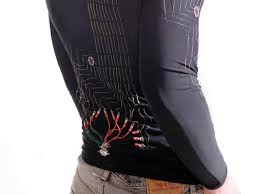 The terms “wearable technology“, “wearable devices“, and “wearables” all refer to electronic technologies or computers that are incorporated into items of clothing and accessories which can comfortably be worn on the body. These wearable devices can perform many of the same computing tasks as mobile phones and laptop computers; however, in some cases, wearable technology can outperform these hand-held devices entirely. Wearable technology tends to be more sophisticated than hand-held technology on the market today because it can provide sensory and scanning features not typically seen in mobile and laptop devices, such as biofeedback and tracking of physiological function.
The terms “wearable technology“, “wearable devices“, and “wearables” all refer to electronic technologies or computers that are incorporated into items of clothing and accessories which can comfortably be worn on the body. These wearable devices can perform many of the same computing tasks as mobile phones and laptop computers; however, in some cases, wearable technology can outperform these hand-held devices entirely. Wearable technology tends to be more sophisticated than hand-held technology on the market today because it can provide sensory and scanning features not typically seen in mobile and laptop devices, such as biofeedback and tracking of physiological function.
 Generally, wearable technology will have some form of communications capability and will allow the wearer access to information in real time. Data-input capabilities are also a feature of such devices, as is local storage. Examples of wearable devices include watches, glasses, contact lenses, e-textiles and smart fabrics, headbands, beanies and caps, jewelry such as rings, bracelets, and hearing aid-like devices that are designed to look like earrings.
Generally, wearable technology will have some form of communications capability and will allow the wearer access to information in real time. Data-input capabilities are also a feature of such devices, as is local storage. Examples of wearable devices include watches, glasses, contact lenses, e-textiles and smart fabrics, headbands, beanies and caps, jewelry such as rings, bracelets, and hearing aid-like devices that are designed to look like earrings.
 As the potential uses in various fields continues to grow, the sociological and cultural impact wearable technology will have in the future should not be minimized. Already, the current hand-held devices available to consumers, such as Smart Phones, iPods and tablets, have changed the technological and social landscapes on a global scale, such that, walking out in public and seeing an individual engaging with a hand-held device is commonplace. Such an image was nonexistent only 20 years ago. With that in mind, developers and analysts predict that wearable technology will very quickly change the technological and cultural landscapes once again, and may even change the nature of mobile phones and other hand-held devices entirely.
As the potential uses in various fields continues to grow, the sociological and cultural impact wearable technology will have in the future should not be minimized. Already, the current hand-held devices available to consumers, such as Smart Phones, iPods and tablets, have changed the technological and social landscapes on a global scale, such that, walking out in public and seeing an individual engaging with a hand-held device is commonplace. Such an image was nonexistent only 20 years ago. With that in mind, developers and analysts predict that wearable technology will very quickly change the technological and cultural landscapes once again, and may even change the nature of mobile phones and other hand-held devices entirely.
The first round of technology may be limited, but eventually the companies could compete in a global blood-sugar tracking market worth over $12 billion by 2017, according to research firm GlobalData.
Non-invasive technology could take many forms. Electricity or ultrasound could pull glucose through the skin for measurement, for instance, or a light could be shined through the skin so that a spectroscope could measure for indications of glucose.
Google has been public about some of its plans: it has developed a “smart” contact lens that measures glucose. In a blog post detailing plans for its smart contact lens, Google described an LED system that could warn of high or low blood sugar by flashing tiny lights. It has recently said it is looking for partners to bring the lens to market.
Modal Trigger
Google is developing a contact lens to help diabetics manage their blood sugar levels.Photo: Getty Images
The device, which uses tiny chips and sensors that resemble bits of glitter to measure glucose levels in tears, is expected to be years away from commercial development, and skeptics wonder if it will ever be ready.
Previous attempts at accurate non-invasive measurement have been foiled by body movement, and fluctuations in hydration and temperature. Tears also have lower concentrations of glucose, which are harder to track.
